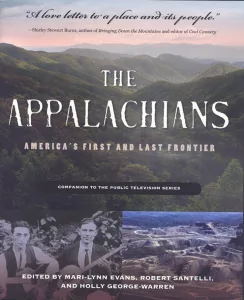 The Appalachians: America’s First and Last Frontier
The Appalachians: America’s First and Last Frontier
Edited by Mari-Lynn Evans, Robert Santelli, and Holly George-Warren
Morgantown: West Virginia University Press, 2012
255 pp., B&W and color illustrations, index
$24.99 softcover
The tale of Appalachia is a familiar one to those that live here: indigenous tribes found a home sheltered among the region’s rock outcroppings; Scots-Irish immigrants made their way over the mountains in search of land and freedom; and the area’s natural resources have long shaped our ways of life in this former wilderness. A companion book to a recent public television series, “The Appalachians: America’s First and Last Frontier” explores the land and the people who call it home through personal essays and chapters focused on history, and a wealth of images that illustrate the region.
Many of the stories found in “The Appalachians” will resonate with Western Pennsylvanians, such as discussions on Monongahela rye whiskey and the taxation practices that lead to the Whiskey Rebellion of 1794, or the impact of coal mining on the region’s economy. Other stories are not as familiar, but sure to entertain and interest (for instance, did you know that Johnse Hatfield, of Hatfield-McCoy Feud fame, worked for U.S. Steel?). Editors Mari-Lynn Evans, Robert Santelli, and Holly George-Warren strive to present more than the usual fare of hillbilly history, and instead broaden the book’s narrative to include a wide range of topics and places, dispelling and explaining the stereotypes associated with Appalachia. The book is a must-read for those who love Appalachian culture and those who wish to learn more about it.
Reviewed by Kelly Anderson Gregg, Assistant Editor of Publications, Heinz History Center
 Allegheny City: A History of Pittsburgh’s North Side
Allegheny City: A History of Pittsburgh’s North Side
By Dan Rooney and Carol Peterson
Pittsburgh: University of Pittsburgh Press, 2013
264 pp., illustrations, index
$24.95 cloth
The Market House. The Thaw family. The Mexican War Streets district. The Rooneys. These are just a few of the iconic places and people that make Pittsburgh’s North Side a city treasure. From its humble beginnings along the Allegheny River, to its annexation by the City of Pittsburgh, and its transformation into Western Pennsylvania’s sports capital, the North Side has an important story to tell.
Peterson, an architectural historian, provides an added layer of analysis with discussions of how the North Side changed physically over a 250-year period, tracing the expansion of streets, institutions, and private homes in connection to historical events. Combined with a wealth of images and locals’ personal stories (like Don “Red” Livingston, who fondly remembers squeezing into Art Rooney, Sr.’s station wagon to attend Steelers games with his boyhood friends), “Allegheny City” is sure to delight.
Reviewed by Kelly Anderson Gregg, Assistant Editor of Publications, Heinz History Center
 Props and Jets: The Shifting Relationship Between the United States Air Corps and a Major Industrial City from 1925 to 1948
Props and Jets: The Shifting Relationship Between the United States Air Corps and a Major Industrial City from 1925 to 1948
By Quentin L. Hartwig, Ph.D.
Bennington, Vt.: Merriam Press, 2013
362 pp., 162 photos and drawings, index, appendices
$21.95 paperback
Western Pennsylvania may be the most unknown of early aviation hotbeds. From plentiful airfields and daredevil barnstormers to start-up airlines and military bases, a lot happened here in the early 20th century that has since faded from memory. A couple books in recent decades have addressed the innovators and advances, but now Quentin Hartwig, local authority on aviation and a USAF veteran, delves into the military side of the story in his new book, “Props and Jets.”
Following the history somewhat chronologically, Hartwig begins in 1925 as Allegheny County acquires 40 acres in rural O’Hara Township to create Rodgers Field. He chronicles the successes, failures, and fatalities as aviation blossomed over the next few decades, moving the story towards the opening of the commercial terminal at the Greater Pittsburgh Airport in 1952. Along the way are tales of other airfields too, like Bettis Airport between Homestead and McKeesport, and the much grander Allegheny County Airport in West Mifflin, opened in 1931 when the first generation of landing sites had become outmoded. The County Airport itself soon became too small to serve the booming commercial and military traffic (though it still hosts more than 80,000 takeoffs and landings a year).
Hartwig’s 17 chapters cover everything from construction to crashes, with an emphasis on aspects such as the Air Transport Command and the Army Air Base at Greater Pitt. Photos are numerous and interesting, including old large-negative photos, letters, and newspaper clippings (though one wishes for better reproduction than the large half-tone dots allow to see details better). Best of all, each chapter concludes with endnotes, a blessing to all who wish to delve deeper into the subjects by following his trail of sources. Appendices supply detailed lists of such things as commanders, accidents, and even air traffic controllers.
Previous books covered much of the basic history, most notably “High Frontier: A History of Aeronautics in Pennsylvania” by Professor William F. Trimble (former editor of the forerunner to Western Pennsylvania History magazine), but it has now been three decades since its publication. More recently, “A Place in the Sky: A History of the Arnold Palmer Regional Airport and Aviation in Southwestern Pennsylvania, 1919-2001” by Richard David Wissolik et al, was published by Saint Vincent College Center for Northern Appalachian Studies, but it’s emphasis was on the eastern portion of the region. With “Props and Jets,” readers get another opportunity to explore the ups (and downs) of local aviation.
Reviewed by Brian Butko, Director of Publications, Heinz History Center